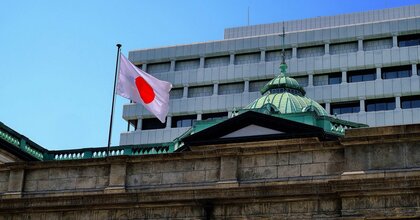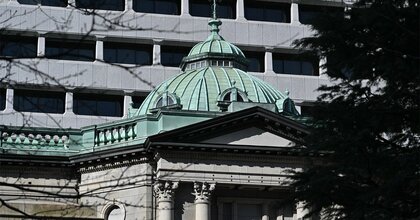Originally published in Japanese on August. 1, 2023
Room to act
The normalization of monetary policy is considered to be the BOJ’s biggest challenge. But this first change to the easing program – made at the third monetary policy meeting under Governor Kazuo Ueda, who has continued the unconventional monetary policy of former Governor Haruhiko Kuroda – is somewhat difficult to understand.
Despite the BOJ’s stated goal of “enhancing the sustainability of monetary easing,” one can read the move as initial one of many “stepping stones” toward an exit from massive easing measures.
The post-decision statement released by the BOJ and Ueda’s press conference after the meeting emphasized that the policy change was not intended to reduce monetary easing. Ueda said that there is no change in his thinking that monetary easing must continue because current conditions are not conducive to achieving the 2% inflation target in a stable and sustainable manner.
Consumer prices have been rising at a rate of more than 2% since April 2022, so one could naturally think that the inflation target has already been achieved, and that the BOJ’s decision would come under criticism.
However, Ueda said that he is not confident about the strength or timing of increases in inflation through the next fiscal year after a slowdown stemming from companies passing on cost hikes to consumers, as well as deceleration in in overseas economic activities and other factors.
In this sense, the “stable and sustainable achievement of the inflation target is not surely foreseeable at this time.”
On the other hand, Ueda explained the change to YCC by describing it as a precautionary measure to prepare for the upward pressure on long-term interest rates that would occur in the event of a clear improvement of the price outlook in the future. He noted that while 10-year yields are unlikely to rise significantly under the current price outlook, there are upside risks to prices due to changes in corporate pricing, wage hikes, and other factors, as well as stronger inflation expectations.
If the price outlook actually improves and long-term interest rates experience upward pressure, Ueda said, ex post YCC revisions would destabilize financial markets. He cited the confusion caused by changes to YCC last December, when the fluctuation band was expanded when long-term interest rates came under growing upward pressure.
“It would be quite difficult to respond to risks after they become apparent. We need to make room now for long-term interest rates to rise above 0.5% when the risk of an upward swing in prices becomes apparent in the future,” he said. “I thought now was the right time [to change YCC, because the JGB market had calmed].”
On the fact that the BOJ's response to an actual change in long-term interest rates in the range of 0.5% to 1% was more flexible than before, Ueda said, “If [the rise in long-term interest rates] is not a speculative move but a reflection of economic and price conditions, we will have more room to reflect market views.”
Upside risks
Considering Ueda’s comments at his press conference, several important points emerge when thinking about the BOJ’s future monetary policy.
First, the BOJ is aware that there is a higher risk of an upward swing in the price outlook, even if it is not certain at this point that the 2% inflation target will be achieved in a stable and sustainable manner. In fact, in the current (July) Outlook Report, the Monetary Policy Board members significantly revised upward their forecast for core consumer price, which excludes fresh food, inflation for fiscal 2023 to 2.5% from 1.8% in the previous report (April).
Although the outlook range for fiscal 2024 is largely the same as the previous year, the risk assessment chart regarding the price outlook shows that the majority of policy board members recognize the upside risks.
Regarding upside risks to the price outlook, the Outlook Report noted that in addition to the continued improvement in the macro supply-demand gap due to above-potential growth, the actual continuation of high inflation under adaptive expectation formation could result in higher household and business inflation expectations and changes in price and wage setting behavior.
The previous spring wage negotiations, which resulted in the highest wage increase in 30 years, and the spread of companies passing on cost increases, suggest that these risks are already becoming apparent.
Stripping down YCC
The second point is that the BOJ's assessment of the trade-off between the benefits and side effects of YCC has changed, as both prices have risen and the economy has firmed.
Under YCC, the BOJ's suppression of nominal long-term interest rates, even under conditions of higher inflation, will have the effect of easing real long-term interest rates. At the same time, however, the BOJ will need to purchase more JGBs to keep nominal long-term interest rates within the fluctuation band, which will further distort price formation in the JGB market.
In other words, both the intended effects and side effects of YCC are maximized when prices rise.
At his press conference, Ueda expressed his willingness to tolerate a certain level of rises in long-term rates in light of the changing circumstances of rising prices and improving economic conditions, thereby “reducing the easing effect [of YCC] but also the side effects.” He added, “We are trying to change the easing effect little by little,” emphasizing the significance of weakening both the main effects and side effects of YCC and adjusting the balance between the two.
This leads to the third point of consideration: The BOJ has come to place more emphasis on the relationship between YCC and the fundamentals of the real economy in terms of prices and economic outlook, rather than the relationship with decline of function in the JGB market as it previously did. This is an important point when thinking about the future of monetary policy.
Even after the most recent change to YCC, if the 10-year yield actually approaches 1%, the BOJ may counter with massive JGB purchases, including through its fixed-rate purchase operations.
However, based on Ueda's comments at the press conference, it seems more likely that the BOJ will respect the prevailing market conditions rather than sticking to its traditional policy of holding down interest rates through massive purchases of JGBs when the upward pressure on long-term interest rates is because of fundamental factors, such as a favorable change in the view of prices.
A scenario in which YCC is effectively reduced to a bare-bones framework, either through another change to the fluctuation band or an increase in its the upper limit, or through more restrained government bond purchases, is becoming increasingly realistic.
Focus on fundamentals
Considering these three points together, the recent policy change indicates that the BOJ has effectively stated its policy of from this point on comprehensively managing YCC in line with fundamental trends based on the price outlook.
One could say that it is a natural change in an economic environment where prices and the economy are improving that the BOJ has shown a more tolerant attitude toward upward pressure on long-term interest rates due to fundamental factors.
Instead of defending the upper limit of the fluctuation band to maintain and enhance the effects of monetary easing, the central bank will carefully assess whether movements in long-term interest rates are reasonable in light of economic fundamentals, and it will respond by using JGB purchases and other measures in line with the pace and level of interest rate increases.
In the parlance of foreign-exchange interventions, the BOJ’s change is reminiscent of the shift from the “line in the sand” style of maintaining a specific rate through mass intervention to the “lean against the wind” style that focuses on addressing the speed of rate fluctuations.
This point enables the BOJ to distance itself from concerns about and consideration for the function of the JGB market. Additionally, in terms of dialogue with financial markets, which has been a major issue, the BOJ and markets will find it easier to share an approach to and thinking about ending monetary easing by focusing only on the price outlook.
In light of this, the BOJ's emphasis on this policy modification as necessary to maintain easing and to enhance the sustainability of the YCC is only a matter for the present. More importantly, the operational flexibility in YCC contains a stepping stone toward the future unwinding of monetary easing.
In several years’ time when observers look back on the flexibility inserted into YCC, I believe that these changes will be judged to have led to the beginning of the end of monetary easing.
(Originally written in Japanese by Tetsuya Inoue, translated and edited by Connor Cislo)











